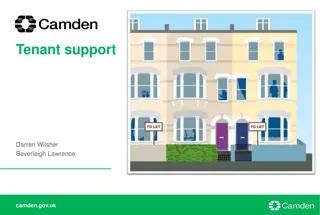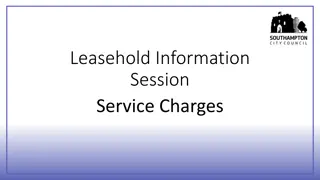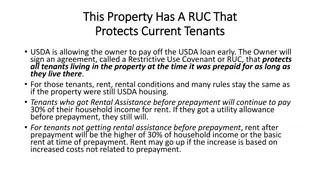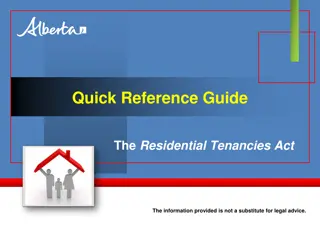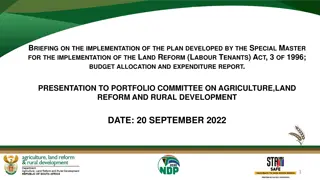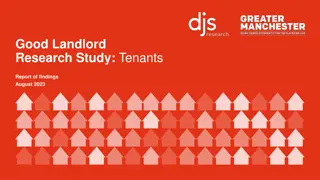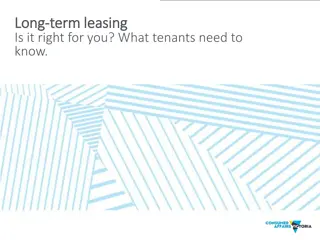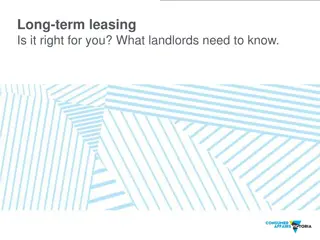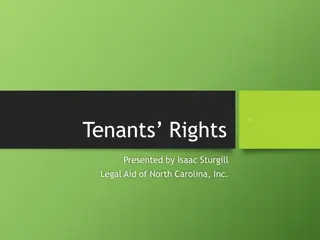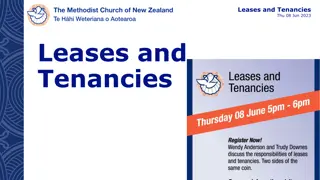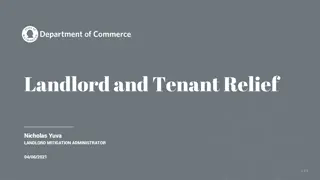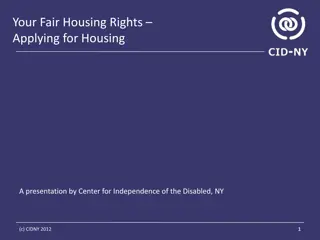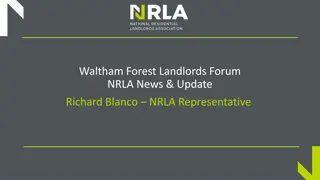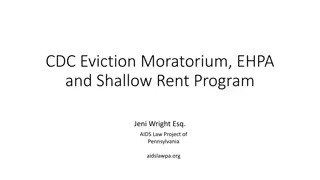Understanding Disrepair: Legal Guidance for Tenants and Landlords
Disrepair Project at University House Legal Advice Centre provides a comprehensive overview of what constitutes disrepair, relevant laws and guidance, and the local authority's legal obligations. The project aims to clarify what falls under disrepair, what doesn't, and offers pathways for both tenants and landlords to address issues effectively.
Download Presentation

Please find below an Image/Link to download the presentation.
The content on the website is provided AS IS for your information and personal use only. It may not be sold, licensed, or shared on other websites without obtaining consent from the author. Download presentation by click this link. If you encounter any issues during the download, it is possible that the publisher has removed the file from their server.
E N D
Presentation Transcript
Disrepair Project University House Legal Advice Centre 20 May 2024
Overview What is Disrepair Law and Guidance Regarding Disrepair What is not Disrepair Objectives Local Authority's Legal Obligations Pathways
The Disrepair Project will be delivered by University House in collaboration with pro bono lawyers from leading commercial law firms. The main aim of the project is to utilise pro bono capacity to undertake casework in an area of great legal need for a group of vulnerable clients. It is hoped that the work of the project can feed intostrategiceffortsbyUHandotherorganisations workingto: influence policyaround theimportance ofthe availabilityofLegalAid forDisrepair casesbeyondthe currentscope.
The Disrepair Project- Background Throughout London, there are 1000s of vulnerable families trapped in poorly maintained dwellings with key players, such as local authorities seemingly unable or unwilling to effectively intervene, indeed, local authorities are themselves often guilty of forcing people to remain in unfit dwellings. Since LASPO 2012 a tenant can only get legal aid for a disrepair case in limited circumstances and once the works are done there is no legal aid for the compensation claim. Some firms take instruction of disrepair under a Conditional Fee Agreement,in a limited circumstance.However, a large group of vulnerable clients are left without support, legal advice and representation. The project will primarily focus on gathering evidence to make a case forExceptional Legal Aid Funding to issue a claim. Additionally, the projectwill robustly pursuethe local authorites tomeets its obligation under the Housing Act 2004.
What is Disrepair Disrepair is where part of a house or a flat has deteriorated. o Water ingress; o Dampness? o Inadequate heating? o Defective drainage & water supplies; o Something that renders the property in some way unsafe?
What is not disrepair Repair does not include improvement.Work which substantially improves or changes the dwelling unlikely to constitute repair o Also, there is, in general, no obligation to remedy an inherent defect. o Problems which result from a defect in design, such as a lack of CWI, or a lack of DPC will not normally be disrepair . o Condensation damp: No recourse to s.11 LTA 1985 o
What is Included Under the express terms Those implied by theLandlord and Tenant Act 1985, s 11(LTA 1985). This covers: o Structure and exterior : walls, roofs, foundations, drains, guttering, external pipes, windows, external doors; o Installation for the supply of water, gas, electricity and sanitations (basins, sinks, baths, toilets and associated pipework, gas and water pipes, electrical wiring); o Installations for space and water heating (water tanks, boilers, radiators, gas lines, fitted electrical lines or fitted heaters).
What needs to be proven? Consider each point : Is it disrepair? Is it within the landlord s repairing obligation? Does the landlord know? Was notice given? Actual or constructive? Has more than a reasonable period of time elapsed between notice and repair? What is the damage or losses, if any? Do they flow?
Repair obligations under tenancy agreement Housing Association / Local Authority s repair policy The date when the disrepair was first brought to landlord s attention. Emails, phone calls Information needed Repair log The extent of disrepair, Impact on family members inconvenience etc Any special damages? Any compensation paid in the past? Any rent arrears?
Landlords repair obligations Arises through: Express term in the tenancy agreement Implied term under Section 11(1), Landlord and Tenant Act 1985 Common law repair responsibilities Is it otherwise caught by section 9A fitness for human habitation claims Legal question but expect need to explain the defect Obligations regarding the fitness of their housing - particularly under the Housing Don t forget about the Defective Premises Act 1972 and the implied terms of the covenant of quiet enjoyment Obligations exist under EPA Housing Act 2004 EPA 1990 Housing Act 2004 Act 2004 (HA 2004). These obligations are triggered by inspection and notice from the local authority. EPA 1990 1990 and the tenant can bring a private prosecution. HA 2004
Express term in the tenancy agreement A landlord cannot contract out of their obligations under section 11 by writing in a term in the tenancy agreement. They can add additional terms. E.g. a landlord must repair appliances such as the oven or washing machine. Social housing tenancy agreements often include express terms regarding disrepair. A tenant should check their tenancy agreement for any additional terms
S 11(1), Landlord and Tenant Act 1985 Section 11(1), Landlord and Tenant Act 1985 In a lease to which this section applies there is implied a covenant by the landlord (a) to keep in repair the structure and exterior of the dwelling-house (including drains, gutters and external pipes), (b) to keep in repair and proper working order the installations in the dwelling-house for the supply of water, gas and electricity and for sanitation (including basins, sinks, baths and sanitary conveniences, but not other fixtures, fittings and appliances for making use of the supply of water, gas or electricity), and; (c) to keep in repair and proper working order the installations in the dwelling-house for space heating and heating water. The effect of s.11(1) LTA is clear. The landlord covenants to keep in repair the structure and exterior of the dwelling house and to keep in repair and proper working order in the dwelling-house the installations mentioned in s.11(1)(b) and (c).
Landlord and Tenant Act 1985 s9A A landlord must make sure the property is fit for human habitation when they grant the tenancy and throughout. Landlord and Tenant Act 1985 section 9A 9A Fitness for human habitation of dwellings in England (1)In a lease to which this section applies of a dwelling in England (see section 9B), there is implied a covenant by the lessor that the dwelling later, at the beginning of the term of the lease, and (a)is fit for human habitation at the time the lease is granted or otherwise created or, if (b)will remain fit for human habitation during the term of the lease. This was implied by the Homes (Fitness for Human Habitation) Act 2018 which came into force on 20 March 2019 A local authority can also inspect a property for hazards and take enforcement action. This overlaps with the repairing obligation under section 11 of the Landlord and Tenant Act 1985. The landlord would be responsible for resolving the issue under both sets of rules.
s.9A(2) and (3) Landlord and Tenant Act 1985 The landlord is not required to: Carry out works because the tenant breached the contract or failed to use the property in a tenant like manner Rebuild or reinstate the property after destruction or damage by fire, flood or storms repair or maintain anything the tenant is entitled to remove from the property When does section 9A not apply?
Imposes a duty of care on landlords and people involved with constructing or working on a dwelling. Legislation- Defective Premises Act Section 1 Duty to build dwellings properly. (1)A person taking on work for or in connection with the provision of a dwelling (whether the dwelling is provided by the erection or by the conversion or enlargement of a building) owes a duty (a)if the dwelling is provided to the order of any person, to that person; and 1972 (b)without prejudice to paragraph (a) above, to every person who acquires an interest (whether legal or equitable) in the dwelling; to see that the work which he takes on is done in a workmanlike or, as the case may be, professional manner, with proper materials and so that as regards that work the dwelling will be fit for habitation when completed. Section 4 Landlord s duty of care in virtue of obligation or right to repair premises demised.
(i) Where the claim relates to a long period of time, the landlord can plead the 1980 Act. With periodic tenants, this will be 6 years. As breach ofrepairing covenant is a continuing breach , this does not amount to an absolute defence but it will reduce damages. Limitation Act 1980: (ii) Note also that where the claim includes a claim for personal injury, the time limit is 3 years.
Environmental Protection Act 1990 A criminal prosecution of the landlord can be brought under the Environmental Protection Act 1990 Other Legislation A local authority can enforce the EPA 1990. For further detail see Chapter 6 Housing Conditions tenant s rights 6th edition published by LAG
Notice The tenant is responsible for notifying the landlord that repairs are required. Notice of repair The tenant may be in breach of their tenancy agreement if they refuse the landlord access to complete the repairs. The tenant must allow access for inspections at a reasonable time of day if the landlord has given at least 24 hours' notice. Records are essential Proof of complaint need only be in basic terms Consider repair logs at an early stage Would a reasonable person be put on notice as to the need for repairs?
A landlord must carry out repairs within a reasonable time once given notice No definition of reasonable time A reasonable time might be within: 24 hours for an emergency repair, such as a burst pipe a week for an urgent repair, such as an insecure window above the ground floor a month for a routine repair, such as a dripping tap What is a reasonable time ? Policy but also common sense
Have losses been sustained? Has the tenant mitigated their loss? Compensation is awarded as a percentage of the rent plus any special damages. Consider the proof of special damages Loss and Damage
Options if the landlord doesnt carry out the repairs Pathway 1 Legal Aid and Exceptional Case Funding (ECF). Take legal action. Pathway 2 report the issue to the environmental health department Pathway 3 make a formal complaint about their landlord to the Housing Ombudsman Pathway 4 Make a homeless application to the local authority. Deemed homelessness How the project will work
Pathway 1 ECF & ISSUING CLAIM This pathway would involve the pro-bono lawyer drafting instructions to the surveyor, unless the client already has enough evidence of the disrepair and then making the ECF application
What is exceptional case funding? Civil legal services which are not within the scope of Schedule 1 LASPO are out of scope, andmay potentially be funded as an exceptional case . What is currently in scope of Legal Aid (Sch 1, Part 1, LASPO): Loss of home: para 33 Homelessness: para 34 Risk to health or safety in rented home: para 35 Proceedings under section 1 of the Anti-socialBehaviour,Crime and Policing Act 2014: para 35 Injunctions under section 3 or 3A of the Protection fromHarassment Act 1997: para 36 Counterclaim in possession proceedings (not extended to PI Claim)
ECF TEST Following the case ofGudanaviciene[2014] EWCACiv162, assessingwhether a case engaging Convention rights requires funding is effectivelya three-way balancing act. The factors which need to be addressed are: 1. The legal, factual and procedural complexity of the matter; 2. The importance of what is at stake; and 3. The ability of the applicant to represent themselves withoutlegal assistance. Note that ECF cases must still meet the usual legal aid means and meritscriteria.
Drafting the ECF applications, including Preparing a Completing the ECF1 application and drafting a statement of case covering the merits and human rights test; and ECF Application Completing the Legal Aid application form and attaching the necessary documents; and Creating a comprehensive referral bundle for a Legal Aid lawyer to take on the disrepair application if the ECF is granted, including: Preparing a case summary, chronology and statement of issues Compiling documentary evidence in support of the client s case
If an ECF application is refused, you can apply to the LAA for an internal review. The internal review should be made on form APP9E, which should be provided with any refusal. A request for internal review must be made within 14 days of the refusal. The LAA aims to process applications for internal review within 10 working days. There is no further right of appeal or review process. A refusal to grantECF on internal review can only be challenged by judicial review, which is within the scope for legal aid. Unsuccessful ECF Application
Case Study- Pathway 1 PC has a housing association tenancy. Shortly after the outset of the tenancy, there were problems at the property, including a lack of hot water and heating, draughts, water ingress, and damp. Despite raising the issues with her landlord on numerous occasions the problems were not properly addressed and worsened significantly over time. PC also involved local authority s environment team to put pressure on the landlord. PC is in receipt of Universal Credit. PC wants us to send a letter before action to the landlord.
Case Study- Pathway 1 What Legal Aid forms will need to be completed for Timothy s ECF application? CIV ECF1 form CIV APP 1 form CIV MEANS 2 form as PC is in receipt of Universal Credit
Pathway 2 Write to Environmental Health Team This pathway would involve the pro-bono lawyer drafting instructions to the surveyor and then drafting a comprehensive letter ( or 'Formal Complaint') to the Environmental health team to carry out an inspection under the Housing, Health & Safety Rating System (HHSRS).
Housing Health and Safety Rating System The Housing Health and Safety Rating System (HHSRS) is a framework used by local authorities to assess housing conditions. There are 29 prescribed HHSRS hazards including: damp and mould excess heat and cold risk of falls and electrical hazards https://www.legislation.gov.uk/uksi/2005/3208/schedule/1/made Hazards are divided into category 1 and 2. Category 1 hazards are the most serious where a local authority must take action. Under the HHSRS a local authority: carries out inspections of rented housing identifies whether any specified hazards are present categorises those hazards according to objective criteria
HHSRS A local authority can also inspect a property for hazards and take enforcement action. A report by a local authority could beused as evidence that a property is unfit for human habitation. There is no requirement that a local authority must haveinspected for a property to be found unfit. It might be enough for a tenant to refer to the relevant parts of theHRSRS operating guidance A home is unfit for human habitation if it is defective to the point where it is not reasonably suitable for occupation. The courts have held that a property is not reasonably fit for habitation if the state of repair means an occupier might be injuredor experience injury to health as a result ofordinary use of theproperty.Morgan v Liverpool Corporation [1927] 2 KB 131, CA, Summers v Salford Corporation [1943] AC 283
Case Study- Pathway 2 JK has Assured shorthold tenancy. He began complaining that the property was damp and of a water leak from the overflow pipe of the flat above, giving rise to water penetration at the property. This resulted in damage to her property. In brief, the water cascaded down from the overflow pipe, which caused a considerable amount of splashback which soaked into the walls and a door of our client s property. The drain around the base of the Property, which should have been able to carry the water away, simply could not cope with the quantity of water gushing out constantly from the overflow pipe. As a result of this and other disrepair, her entire flat was damp and there was mould throughout.
Pathway 3 Housing Ombudsman
Pathway 3 Housing Ombudsman FROM APRIL TO DECEMBER 2023 THERE WAS A 91% INCREASE IN CASES REFERRED TO THE OMBUDSMAN, COMPARED TO THE SAME PERIOD THE PREVIOUS YEAR. CHANGES TO THE HOUSING OMBUDSMAN SCHEME TOOK EFFECT FROM 1 OCTOBER 2022, MAKING IT EASIER FOR RESIDENTS TO MAKE COMPLAINT. THE REVISED SCHEME REMOVES THE DEMOCRATIC FILTER FOLLOWING A CHANGE IN THE LAW. IT MEANS RESIDENTS WILL NO LONGER HAVE TO CONTACT A DESIGNATED PERSON OR WAIT EIGHT WEEKS THE SOCIAL HOUSING (REGULATION) ACT 2023 GAVE THE HOUSING OMBUDSMAN NEW POWERS AND DUTIES FROM 1 APRIL 2024, INCLUDING A NEW STATUTORY CODE FOR HANDLING COMPLAINTS AND A DUTY TO MONITOR WHETHER LANDLORDS COMPLY. THEY ARE NOW ABLE TO ORDER A LANDLORD TO EVALUATE A PARTICULAR POLICY OR PRACTICE TO PREVENT SERVICE FAILURE BEING REPEATED. THE EXPANDED AUTHORITY ENABLES THE OMBUDSMAN TO REQUIRE LANDLORDS TO GO BEYOND THE SCOPE OF INDIVIDUAL COMPLAINTS AND SEEK TO ADDRESS ANY WIDER ISSUES.
Pathway 3 Housing Ombudsman New Complaint Code: The Ombudsman's complaint handling code is now a statutory requirement for social landlords. Landlords must recognise the different between a service request and a complaint and set this out in their complaints policy. Maximum two stages complaint process: oAcknowledgement of complaint within 5 working days(WD) oStage 1 response within 10 days, can be extended for another 10 WD oStage 2 response within 20 working days.
Pathway 3 Housing Ombudsman o To file a complaint with the Housing Ombudsman, tenants must first exhaust their landlord s internal complaints procedure. o The Housing Ombudsman has the power to investigate complaints and to make recommendations to landlords to resolve the issue. The Housing Ombudsman can award compensation o A complaint must be referred to the service within 12 months from the date of the landlord s final response. o This pathway would involve the pro-bono lawyer drafting instructions to the surveyor and then if required, assisting the client in following the complaint through the landlords complaints procedure and then submitting a complaint to the Housing Ombudsman.
Case Study- Pathway 3 GH has a secure tenancy with the London Borough of Tower Hamlets. He lives in a 2- bedroom flat with his wife and 2 children. The bathroom ventilation fan has stopped working and this has led to a growth of damp and mold. GH first reported the disrepair in January 2023. The works had been raised but the council had agreed to fix the ventilation fan, treat the damp and mould on the ceilings and repaint. It is now May 2024 , and despite chasing several times a month, the works have not been carried out as agreed. GH has approached UH for assistance.
Case Study- Pathway 3 Check if the local authority s complaints policy has been exhausted. Stage 1 complaint, stage 2 complaint. The pro-bono lawyer could draft instructions to the surveyor and then if required, assist the client in following the complaint through the landlords complaints procedure and then submitting a complaint to the Housing Ombudsman Depending on the outcome of the investigation, the Housing Ombudsman may set out orders and recommendations to the landlord in their report to put things right. This could mean telling the landlord to: pay compensation apologise review its policies and procedures complete any outstanding repairs Orders aim to put things right to resolve the individual complaint and landlords are obliged to follow the orders. Recommendations are made where wider learning or improvement could improve housing services across the landlord for the benefit of other residents.
Pathway 4 Homelessness
Pathway 4 - Homelessness This pathway would involve the pro-bono lawyerdrafting instructions to the surveyor and then using this to draft a deemed homeless letter to support the homeless application to the local authority. Under Housing Act 1996 s175 (3) a person who has accommodation is homeless if it is unreasonable for them to continue to occupy that accommodation.
Case Study- Pathway 4 AS lives in a studio flat on the third floor of a purpose-built apartment. The flat has a room, a separate kitchen, and a toilet (with bathroom). The size of the only room is 4.3 meter by 4.5 meter. The room is too small to accommodate necessary furniture for the four. There is no space to put a desk or give children a space to play. There is a double bed, a wardrobe and two cot beds filled out the space of the room. There is no space to keep a desk, or a sofa or toys. The flat suffers from the effects of widespread damp and mould. A year ago, the flat was flooded with sewage water after main pipeline of the building burst open by heavy blockage. The furniture, carpet, clothes were all ruined as a result. AS lives there with his wife and two children. The children are aged 4 and 3. The four year old suffers from a chronic cough and cold. The three year old has a chronic cough condition, runny nose, and cold. AS himself catches a cold every now and then.
UH will complete initial screening. Pro-bono advisor will take instructions and interview the client. Pro-bono advisor will gather relevant evidence. Discuss with UH supervisor which pathway would be most appropriate for the client. Request a surveyors report if applicable. Start Pathway work (ECF application, request for investigation, complaint, homelessness supporting letter) Starting a case
Resources Available Training Slides Recording Volunteers' handbook Template letters and applications Access to University House s Housing Solicitor who will supervise all work


